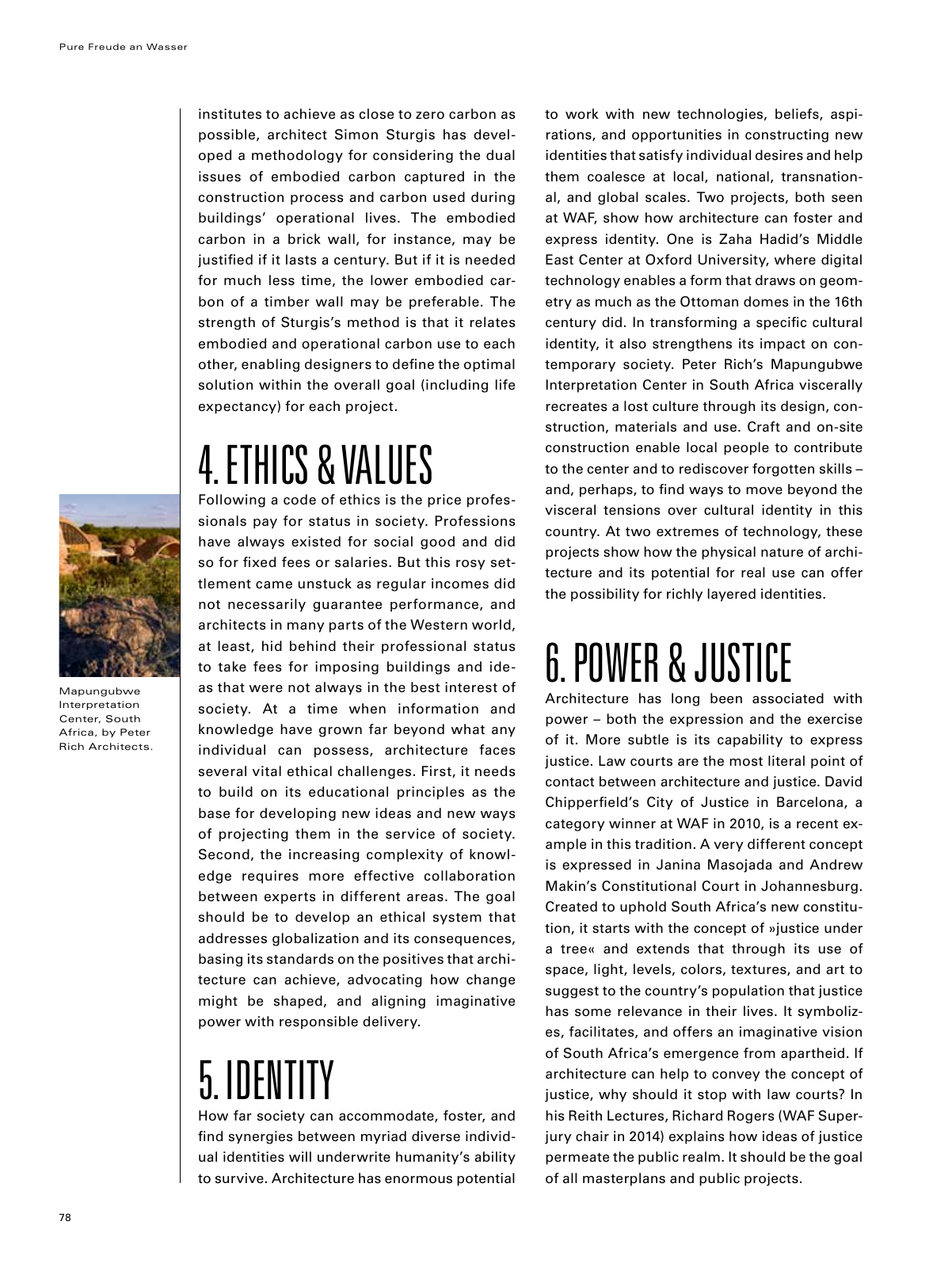78 Pure Freude an Wasser institutes to achieve as close to zero carbon as possible architect Simon Sturgis has devel oped a methodology for considering the dual issues of embodied carbon captured in the construction process and carbon used during buildings operational lives The embodied carbon in a brick wall for instance may be justified if it lasts a century But if it is needed for much less time the lower embodied car bon of a timber wall may be preferable The strength of Sturgis s method is that it relates embodied and operational carbon use to each other enabling designers to define the optimal solution within the overall goal including life expectancy for each project 4 ETHICS VALUES Following a code of ethics is the price profes sionals pay for status in society Professions have always existed for social good and did so for fixed fees or salaries But this rosy set tlement came unstuck as regular incomes did not necessarily guarantee performance and architects in many parts of the Western world at least hid behind their professional status to take fees for imposing buildings and ide as that were not always in the best interest of society At a time when information and knowledge have grown far beyond what any individual can possess architecture faces several vital ethical challenges First it needs to build on its educational principles as the base for developing new ideas and new ways of projecting them in the service of society Second the increasing complexity of knowl edge requires more effective collaboration between experts in different areas The goal should be to develop an ethical system that addresses globalization and its consequences basing its standards on the positives that archi tecture can achieve advocating how change might be shaped and aligning imaginative power with responsible delivery 5 IDENTITY How far society can accommodate foster and find synergies between myriad diverse individ ual identities will underwrite humanity s ability to survive Architecture has enormous potential to work with new technologies beliefs aspi rations and opportunities in constructing new identities that satisfy individual desires and help them coalesce at local national transnation al and global scales Two projects both seen at WAF show how architecture can foster and express identity One is Zaha Hadid s Middle East Center at Oxford University where digital technology enables a form that draws on geom etry as much as the Ottoman domes in the 16th century did In transforming a specific cultural identity it also strengthens its impact on con temporary society Peter Rich s Mapungubwe Interpretation Center in South Africa viscerally recreates a lost culture through its design con struction materials and use Craft and on site construction enable local people to contribute to the center and to rediscover forgotten skills and perhaps to find ways to move beyond the visceral tensions over cultural identity in this country At two extremes of technology these projects show how the physical nature of archi tecture and its potential for real use can offer the possibility for richly layered identities Mapungubwe Interpretation Center South Africa by Peter Rich Architects 6 POWER JUSTICE Architecture has long been associated with power both the expression and the exercise of it More subtle is its capability to express justice Law courts are the most literal point of contact between architecture and justice David Chipperfield s City of Justice in Barcelona a category winner at WAF in 2010 is a recent ex ample in this tradition A very different concept is expressed in Janina Masojada and Andrew Makin s Constitutional Court in Johannesburg Created to uphold South Africa s new constitu tion it starts with the concept of justice under a tree and extends that through its use of space light levels colors textures and art to suggest to the country s population that justice has some relevance in their lives It symboliz es facilitates and offers an imaginative vision of South Africa s emergence from apartheid If architecture can help to convey the concept of justice why should it stop with law courts In his Reith Lectures Richard Rogers WAF Super jury chair in 2014 explains how ideas of justice permeate the public realm It should be the goal of all masterplans and public projects

Hinweis: Dies ist eine maschinenlesbare No-Flash Ansicht.
Klicken Sie hier um zur Online-Version zu gelangen.
Klicken Sie hier um zur Online-Version zu gelangen.